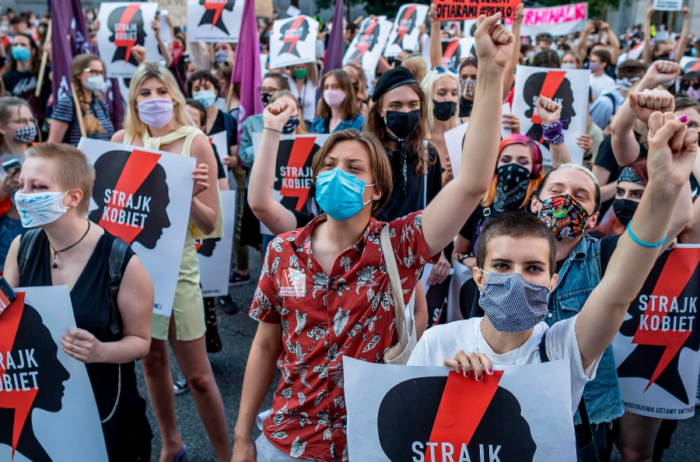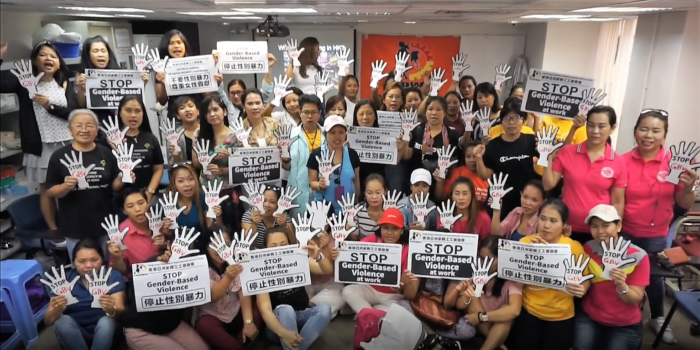Progress on gender equality is under threat today. Efforts to accelerate the gains made for women’s rights are increasingly coming under attack from authoritarian governments, fundamentalist groups and others who are threatened by women’s progress. Pushback against gender equality can range from denial and inaction to aggressive backlash and repression, and it is increasingly being used as political currency or to win votes. Women are fighting back by rallying collective action, harnessing social media, and fostering solidarity through dialogue and spreading awareness of the evidence that demonstrates the benefits of gender equality for all of society.
RALLYING COLLECTIVE ACTION
To counter resistance to gender equality it is critical to rally collective action at all levels. This includes strengthening global and national efforts to reform and enforce gender equality laws and mobilizing support for women-led mass demonstrations to advance progress.

- The Istanbul Convention is the first European treaty to set legally binding standards to prevent and eradicate gender-based violence and domestic violence. However, there is significant and growing opposition towards the convention from governments claiming that the legislation threatens “family values.” The backlash has been met with large protests across Turkey, Poland and Croatia. After Poland began its formal withdrawal from the treaty in July 2020, women across the country have mobilized to campaign against the withdrawal and demand government action to prevent violence against women.
- Armenia adopted landmark legislation in 2013 on Equal Rights and Equal Opportunities for Women and Men, despite a strong tradition of patriarchal norms. The law met powerful backlash fueled by ultranationalist groups, who propagated hate speech, condemned women’s rights advocacy for threatening traditional family values, and targeted activists through online harassment. However, this campaign was successfully countered by women’s groups, including the Coalition to Stop Violence against Women, who used social media as a tool to energize collaboration across women’s rights and other allied organizations.
- In 2016, more than 100,000 Poles publicly demonstrated and wore black to show opposition to proposed legislation banning all abortions. Numerous restaurants, universities, and other employers showed their support by allowing women to take the day off to protest. Solidarity demonstrations in Barcelona, Berlin, Brussels, Paris, and London joined the call to deter passage of this legislation and in the face of this mass activism, the proposed law did not receive enough votes in parliament. However, the court’s recent decision to implement a near-total ban has sparked another wave of protests from women’s rights advocates who vow to fight the ban.
- In Malaysia early in the COVID-19 crisis, women mobilized to end entrenched government sexism. The Women, Family, and Community Development Ministry had issued a series of posters and infographics that outlined “good behavior” for women at home, including dressing well, wearing makeup, and not irritating husbands. Social media backlash from individuals and women’s organizations pressured the government to withdraw the posters and issue a public apology.
HARNESSING SOCIAL MEDIA CAMPAIGNS TO ADDRESS INJUSTICE
Social media can be a force multiplier in campaigns for gender equality, raising widespread awareness at often unprecedented speed and giving a voice to women who are often silenced in public spaces. Social media can engage younger populations, build broader networks of changemakers, and increase the pressure on political leaders to act.

- The #MeToo movement has shattered the silence around sexual assault by lifting the stigma attached to survivors and overcoming the obstacles to speaking out. Within a year of going viral, “#MeToo” was tweeted more than 19 million times and has inspired a global movement. Widely used in at least 85 countries, #MeToo has been translated into many different languages, including #YoTambien in Spain and Latin America, #BalanceTonPorc in France, and #QuellaVoltaChe in Italy.
- China’s #MeToo movement gained traction in 2015 when five Chinese feminists were detained for planning to distribute leaflets warning of sexual harassment on public transit. Yet the state continues to crack down on protests, and #MeToo and the term feminist are banned in China. Despite widespread repression, feminist activists such as Lü Pin and Liang Xiaowen have adopted creative ways to continue their work, including university-wide anti-sexual harassment petitions, using their bodies as performance art in public spaces, and adopting innovative hashtags across social media platforms to circumvent state censorship. For example, activists used the homonym Mi Tu, or “rice bunny” to get around the ban of #MeToo in China.
- The #NiUnaMenos campaign began in 2015 to fight gender inequality and violence against women in Argentina. The name translates as ‘not one less’, meaning that not one more woman should die at the hands of men, and has motivated hundreds of thousands of women to take to the streets in protest. In Mexico, thousands of women have joined country-wide strikes and massive protests against femicide, calling out the government’s failure to address violence against women and girls. #NiUnaMenos has spread across Latin America and stands as a powerful international campaign against gender violence.
- The hashtag “#AfghanWomenWillNotGoBack” has helped unify women’s demands to the Taliban for an end to gender-based violence, and #MyRedLine has been used by Afghan women to record video clips sharing their “red lines” for any internal peace agreement.
Preventing malign use of social media, including using platforms to harass women politicians and human rights defenders, is a key component of preventing backlash to the gender equality agenda.
- Despite the power of social media to amplify women’s rights advocacy, online abuse and disinformation are widespread. Women and girls are experiencing significant levels of hate speech online, and they are 27 times more likely to experience harassment online then men and boys. Rising online violence against women and girls is also linked to wider backlash trends at the national and global levels. The European Women’s Lobby has identified several strategies for countering online violence including #HerNetHerRights, a project to analyze the current state of online violence against women in Europe and identify resources, safety trainings, and awareness raising to address digital risks.
- International standards and legal frameworks must combat all forms of violence against women, whether online or offline. CEDAW, the Istanbul Convention, and other national legislation must include a recognition of the online dimension of violence and list online hate speech as a cyber-crime.
- Media, tech companies, and other private sector stakeholders should participate in multilateral forums to leverage their networks and ensure online violence against women is eradicated. As powerful social actors, they must be responsibly engaged, transparent, and accountable for what is being posted on their platforms and how they evaluate claims of online hate.
- A new study by the Wilson Center’s Science and Technology Innovation Program, “Malign Creativity: How Gender, Sex, and Lies are Weaponized Against Women Online,” explores the gendered abuse and disinformation across social media platforms and provides recommendations for policymakers and employers to mitigate gendered-based harassment.
FOSTER SOLIDARITY THROUGH DIALOGUE AND EVIDENCE
Countering resistance within government and policymaking spaces is key to advancing gender equality at all levels. Conferences on women’s issues within the framework of the UN system, such as the Commission on the Status of Women, are critical for pressuring national governments to advance the agenda. However, pushback movements within the UN system must be countered. Engaging women’s groups and independent human rights mechanisms, such as the UN Human Rights Council, in structured discussions on gender equality is key to sharing best practices and implementing reforms.
Resistance to gender equality can occur at all levels of society, from the boardroom to the household level. In every setting, each person must take it upon themselves to create an inclusive dialogue and utilize evidence that advances understanding of the universal gains of gender equality. In Australia, VicHealth has proposed several strategies to help navigate resistance in everyday conversations and interactions, including:
- Encouraging dialogue, persuasion, and explanation to engage in ongoing conversations challenge harmful norms; and adopting inclusive language to create the space for diverse views.
- Framing the case for gender equality with shared values, such as the Victorian Trades Hall Council’s “Stop Gendered Violence at Work campaign,” which positions sexism, discrimination, and violence against women as an occupational health and safety hazard.
- Using fact-based arguments and evidence to cite the universal gains from gender equality, such as the Georgetown Institute for Women, Peace and Security’s Global Women, Peace and Security Index and McKinsey & Company’s “The Power of Parity” report.
- Ensuring access to education, specifically on the teaching of gender equitable values and behaviors, LGBTQI rights, and comprehensive sexuality education, and tackling stereotypes that persist.
